 |
Among Russians St. Michael is especially venerated. He was viewed as interceding in Russian conflicts and is typically portrayed as a warrior. Many churches and monasteries in Russia are dedicated to him and it has been said that there is not a city in Russia that does not have a church or chapel dedicated to him. Detail of main iconostasis with Archangel MichaelThis icon, in the Veneration tier of the iconostasis, is the oldest and one of the most hallowed icons in the cathedral. The flyer at the church says it was "made on the orders of Princess Eudocia, the widow of Dmitri Donskoy, who had a vision of St. Michael. The icon, painted around 1399, made part of the iconostasis of the old Archangel Church. St. Michel, a heavenly warrior, is depicted in the centrepiece, wearing armour and a red cloak. He is surrounded by eighteen border scenes depicting the deeds of angels." (The dating is important since this is the time period that the famous Byzantine icon painter Theophanes the Greek is known to have been working at the cathedral with his students.
There had been an earlier church on this spot dedicated to St. Michael. Just before his death in 1505 Ivan III decided to rebuild the old Cathedral of St. Michael so it could serve as a burial place for the tsars and earlier Romanovs. (After Peter the Great, members of the royal family were buried in the Cathedral of Saints Peter and Paul in St. Petersburg.) An Italian architect, who had spent some time in Venice, Alevisio Novi, was entrusted with the design. The plan adheres to the traditional Russian church plan--a traditional six-pillar church with five cupolas, but the exterior exhibits innovative Italianate decorative details. In fact, George Heard Hamilton sees Alevisio Novi more as a decorator than an architect, especially since his exteriors have little relation to interior volumes or structural needs. |
| |
|
e
Views from the northwest and westThe facade is replete with High Renaissance decorative details. Bays are emphatically defined by pilasters. Each register is demarcated by horizontal divisions/cornices and the lower register is an Italianate blind arcade. All of these rational Albertian divisions would have been much more obvious in the original structure which was red brick with stonework for the projecting parts--cornices, arches, capitals and shells. (later the brick was plastered over and painted white. Perhaps the most beautiful decorative element of the cathedral is the large relief shell motif, following the outlines of the zakamoras. The round medallion window of the entrance facade (west) is also Italian in origin.
|
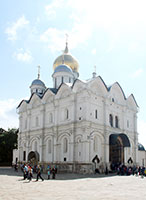 |
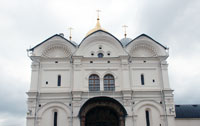 |
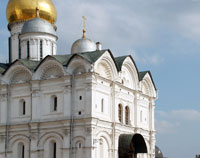 |
| |
|
The north side;
the south side--from the southwest |
 |
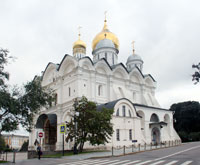 |
| |
|
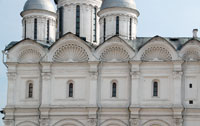 |
Side elevationThe lower register has a blind arcade with pilasters dividing the bays. The upper register has pilasters also with composite capitals and a deep cornice. See details below.
The bays differ in width. The westernmost bay, its placement partly determined by the earlier church, has small rooms at its north and south ends, and smaller windows in the upper storey. |
| |
|
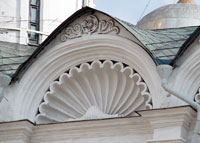 |
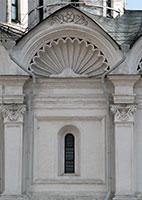 |
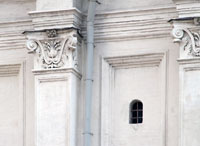 |
| |
|
The roof and domesThe cathedral has one largish dome and four smaller ones. |
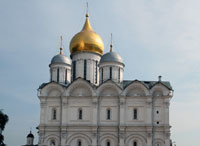 |
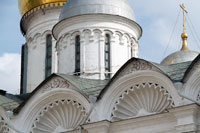 |
| |
|
The western front |
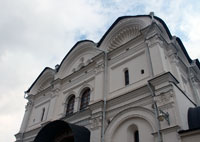 |
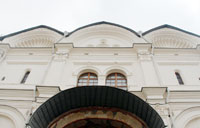 |
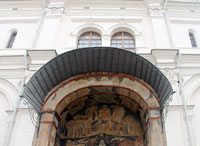 |
| |
|
The main entrance--a portal inside a deep loggiaThis type of entrance was a novelty for Russia at this time. The stylized floral ornament is also imported from Italy.
|
 |
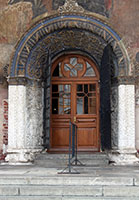 |
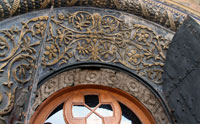 |
| |
|
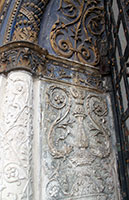 |
Floral ornament |


 Click here to return to index of art historical sites.
Click here to return to index of art historical sites.
 Click here to return to index of artists and architects.
Click here to return to index of artists and architects.
 Click here to return to chronological index.
Click here to return to chronological index.
 Click here to see the home page of Bluffton University.
Click here to see the home page of Bluffton University.

